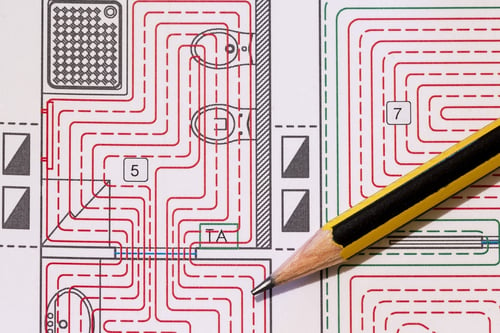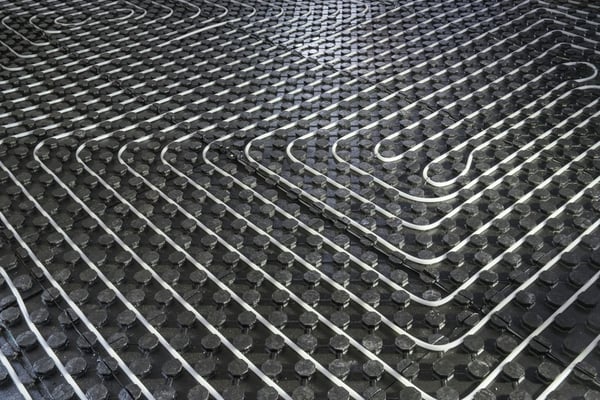Radiant Floor Heating is Ideal for Cold Chicago Winters

Chicago residents say they get used to the brutally cold, snowy winters and temperatures that often start to plummet in September. But most confess that this is the time they stay indoors as much as they can.
Residents talk about Chicago winter’s “harsh whipping wind,” describing the environment as a “frozen hellish desert.” Some say that in winter it’s like “living in a gigantic icebox.” And it’s not just because the winters are generally cold, it is also because Chicago winters are longer than in many other parts of the USA.
When leaving your Chicago home the secret is to layer up, residents say. When at home you need good insulation and an energy-efficient heating system that will keep you warm. If you rent a home, Chicago landlords are obliged, by law, to ensure that houses, apartments, and other residential units are adequately heated from September 15 through June 1. From 8.30 am until 10.30 pm the temperature must be at least 68 degrees, and from 10.30 pm until 8.30 am, when most people are snuggled up in bed, it must be at least 66 degrees.
While landlords are not mandated to use any particular system to comply with the Chicago Heat Ordinance, it makes sense to use a system that is cost-effective and also energy efficient.

Radiant Heating Systems
While not cheap, a radiant heating and cooling (RHC) system is both cost-effective and energy efficient and will ensure thermal comfort in any size building. These systems also operate quietly and are easily integrated with building design. Radiant heating systems may be used to supply heat not only to floors but also to wall panels and ceilings. They deliver heat directly from a warmed surface to people in the room, heating from the ground up. Unlike forced-air heating, radiant heating avoids duct losses and avoids the risk of spreading allergens.
Although all radiant heating systems work according to the same principles of radiation, there are significant differences between radiant floor heating systems and radiant panels used for heating walls and ceilings. It works particularly well, especially in the kind of climatic conditions typically experienced in Chicago, offering exceptionally good comfort levels.
Radiant Floor Heating for Chicago Buildings
There are three different types of radiant floor heating, all of which may be found in Chicago buildings, though the hydronic (liquid) radiant system, that utilizes hot water from a boiler, is undoubtedly the best, most cost-effective floor heating method. The others use electricity or heated air, the latter being the least effective.
All three work by delivering heat up through the surface of the floor rather than via air ducts or through baseboard heaters.
Hydronic Radiant Floor Heating

The most popular type of radiant floor heating, hydronic radiant floors rely on the controlled flow of hot water through tubing laid under the floor. The design of the system may use zoning valves or thermostats and pumps to regulate the temperature.
While hydronic heat installations are comparable in cost to electric floor heating systems, if you’re using a boiler for heating it makes better sense to opt for a hydronic radiant floor heating system. Alternatively, heat pumps may be used, or the system can be linked directly to solar collectors.
Electric Radiant Floor Heating
Not as cost-effective as hydronic radiant floors, electric radiant floor heating involves either a system of electric cables that are built into the floor or mats made from electrically-conductive plastic that are mounted on the sub-floor. Also, they work best when there is a good, solid concrete slab, particularly when it is possible to heat the floor during off-peak hours at night.
The US Department of Energy recommends this type of radiant floor heating for home additions.
Air-Heated Radiant Floors
Air-heated radiant floors are not common largely because they are not cost-effective even when combined with solar heating systems. The system relies on hot air being blown through ducts below the floor, but the air cannot hold very much heat and so they are not very practical either.
Suitable Floor Installations for Radiant Floor Heating
Installation methods used for both electric and hydronic radiant floors are similar, and they may be wet or dry. In essence, wet installations involve embedding tubing or cables in a solid floor like a concrete slab, which is good for storing heat but has a relatively slow thermal response time. Dry radiant floor heating incorporates the same tubing or cables in an air space under the floor making it much more efficient in terms of being able to achieve higher temperatures. There is no so-called “wet” work involved.
Of course, the design of the building will directly affect the installation method used. For instance, a wet installation may involve a relatively thin layer of gypsum, mortar, or concrete over a subfloor that is then tiled or carpeted. Slate, ceramic tiles, and more expensive marble or granite are good floor finishes because they transfer heat well.
A dry installation might require the addition of reflective insulation under the tubes so that heat is directed upwards. Alternatively, the tubing might be installed between two subfloor layers. Some designs incorporate a subfloor made from plywood that is manufactured with both aluminum heat diffuser plates and tubing grooves built in. The latter is considered to be a cost-effective system for new construction. It is also less expensive to set up and generally more convenient. Heating is also more rapid.
The Bottom Line
When assessing whether to incorporate radiant floor heating in a Chicago home or building you need to weigh up long-term advantages versus up-front costs. There is little doubt that any radiant floor heating system is going to cost more than other heating systems, but it will ultimately be more energy efficient and will supply improved comfort levels. This in itself offers an attractive ROI.
If you live in Chicago and are building or retrofitting an old house, our MEP engineering team can help you assess your floor heating needs and will advise whether radiant floor heating is the best option for you.

Michael Tobias
Michael Tobias, the Founding Principal of NY Engineers, currently leads a team of 150+ MEP/FP engineers and has led over 4,000 projects in the US
Join 15,000+ Fellow Architects and Contractors
Get expert engineering tips straight to your inbox. Subscribe to the NY Engineers Blog below.
